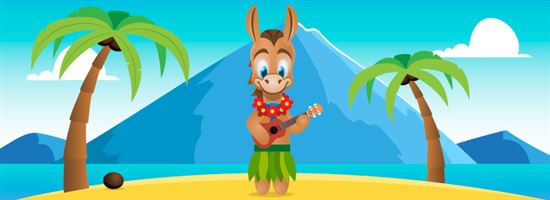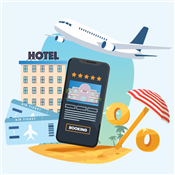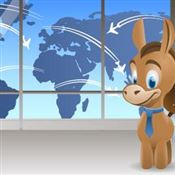Best Time to Visit Hawaii: What You Need to Know
Want to visit Hawaii? Here are the cheapest time to buy airline tickets, best and worst months for tourists, and weather tips for an unforgettable vacation.
 |
| © CreditDonkey |
When is the Cheapest Time to Visit Hawaii
Like any popular tourist destination, Hawaii has its busy and slow seasons. Take advantage of the quieter times to find great deals.
- The Fall
September through the first two weeks of December are the off-peak or "low season" in Hawaii. Decreased demand means lower ticket (and hotel) prices. The one exception is Thanksgiving, when military personnel on the islands make travel arrangements with family. - April and May
The months between the end of the winter rainy season and the start of summer offer great prices and fantastic weather. Take care to avoid the last week of April and first week of May, which coincides with Golden Week, a peak vacation time in Japan.
Even during the busy season, you may find great deals and promotions. Make a habit of browsing travel and airline sites whenever you have a free moment.
How to Save Money on Tickets to Hawaii
- Book at least a month in advance
While opinions vary, most experts agree the ideal time for purchasing tickets is between 40-50 days before you travel. (The overall booking window is 21 to 101 days.) - Fly during the week
Demand for weekday flights is significantly lower than for weekend travel, which means you might save a little extra. Contrary to popular opinion, Sundays—not Tuesdays—are the best day to book economy flights. But the price difference day to day is usually so slight that it's probably not worth waiting. - Be flexible
Willing to adjust your departure and arrival dates? You may save yourself some cash. Also, consider alternate airports. Honolulu (Oahu), Kahului (Maui), and Lihue (Kauai) are among the cheaper options for flying into Hawaii.Tip: Some ticket prices seem too good to be true for a reason. Airlines often have hidden fees, including seat selection and carry-on charges, that won't show up when searching online. Consider these, and any baggage fees, when comparing prices. - Don't drag your feet
If you find an irresistible deal on a flight, don't wait. Airline ticket prices are extremely volatile. You might lose a sweet deal by holding out for a flight that's a few dollars cheaper.Related: Is Costco Travel a Good Deal?
When planning a Hawaiian vacation, there's more to consider than just price. Read on for more tips to help you decide when to travel.
Best Time of Year to Go To Hawaii
 |
| © CreditDonkey |
The temperature stays pretty consistent in Hawaii.
You'll enjoy upper-70s to low 80's no matter what time of year you travel and consistent ocean breezes. The region is tropical so expect some humidity.
People often talk about rainy and dry seasons but the truth is, the islands have their own unique climates. In general, there are two seasons: summer or kau and winter or hoolio.
- Summer: April to October is the "dry season" but this doesn't mean you won't see any rain. Daily showers are common depending on where you stay, but they usually clear up quickly. The skies also tend to be sunnier overall.
Best time for:
- Snorkeling and learning to surf when the seas are calmer and the water is warmest
- Hiking since trails are drier and easier to navigate
- Boat tours
- Snorkeling and learning to surf when the seas are calmer and the water is warmest
- Winter: November through March marks the rainy season. Gray skies are more common. Some areas can also expect daylong downpours but rarely do they affect the whole island. In other words, you'll always be able to find some sun.
Best time for:
- Whale watching, especially late February and early March after calving time.
- Big Wave surfing and spectating. The north shore of Oahu is the best place to catch waves (and catch people catching waves from the safety of the beach).
- Museums
Even during rainy season, some areas get very little bad weather.
Here are a few places to consider if you're worried about your plans being washed out: The Kohala Coast on the Big Island, South Oahu, Western or Southern Maui. In general, Kauai gets more rain than the three popular islands.
- Whale watching, especially late February and early March after calving time.
What Month is Best to Visit Hawaii
Hawaii is near the equator so you can expect upper-70s to low 80 temperatures year round. And weather patterns can vary greatly from island to island.
Here's a handy month-by-month guide for planning your trip:
- January: Expect clouds and some rain, plus more tourists, depending on location. More expensive to visit. Great time for Big Wave surfing on the North Shore of Oahu.
- February: Less rain (and winds) than January but the coolest water temperatures (about 75 degrees). More expensive to visit. An ideal time for whale-watching, especially toward the end of the month when humpback calving season ends.
- March: Typically the biggest rainstorms (though not the most total rain) and more tourists, depending on location. Can be expensive. A good month for fishing, especially marlin and tuna.
- April: Start of the dry season (give or take a couple weeks) and fewer tourists, except during Japan's Golden Week. Easier to find deals on airfare and hotels. Check out the Merrie Monarch Festival on the Big Island.
- May: Sunny weather, fewer crowds (with the exception of Memorial Day) and overall lower prices make May an ideal time to visit. Take advantage of the drier trails and Hawaii's countless hiking opportunities.
- June: Like May, June is a great time to visit but you may see more tourists celebrating the end of the school year. Prices may also be higher. The perfect time for swimming, sun tanning and other beach-related fun.
- July: The weather is near perfect but you may notice more tourists and higher prices. Since it's the height of summer, the evening temperatures stay warmer. Take advantage of the starry evening skies, especially away from the cities.
- August: While Hawaii's tropical temperatures tend to be consistent, August can be a little too-toasty in some areas. It's also a busy month for visitors, which can drive up prices. Calmer seas make this a great month for beginning surfers.
- September: Another great month for weather and usually the fewest visitors. Ocean water temperatures max out in the low 80s. Great air and hotel rates available. If you're planning a wedding, September is a good month to consider.
- October: You might see early seasonal rains, but the oceans will stay nice and warm. Fewer tourists than peak seasons, so deals are available. A great chance for hiking and relaxing at the beach without worrying about weather changes.
- November: Increased rains might change—but shouldn't wash out—your outdoor plans. November boasts the fewest tourists so you can find deals, at least before Thanksgiving. Take advantage of the occasional wet day by exploring museums and basking in Hawaiian culture.
- December: Rainy season has arrived but you'll still find plenty of good weather. Early December is best, before the holidays bring more tourists and higher prices. Take advantage of the fact that all your friends are probably freezing back home. Snap plenty of tropical pictures to rub it in.
Keep reading to find the right island for your visit.
Where to Stay in Hawaii
Hawaii has eight main islands, but only four are major tourist areas: The Big Island, Maui, Oahu, and Kauai. Each has its own unique charms and attractions.
- The Big Island: You'll see a variety of terrains and climates, from snow covered mountains to black sand beaches. The Big Island also boasts Hawaii's only active volcano (though best to avoid that one for awhile.)
The Big Island is perfect for outdoor activities like snorkeling and hiking, great wildlife viewing, culture and history.
- Maui: The second largest Hawaiian island may be best known for its black, red and white sand beach but there's much more to see. You can shop at high end stores in its historic towns, find great restaurants and find fun family activities like whale watching.
Tip: If you're visiting Maui, plan to rent a car and drive the scenic, snaking Hana Highway. Make sure to set your phone camera to panorama mode!
Maui is perfect for adventurers, foodies and luxury travelers.
- Oahu: The most populous island (including state capital Honolulu) is also the most modern. Enjoy museums and monuments, check out the famously huge waves on famous North Shore or stay at inexpensive hotels. Those who don't like crowds might want to stay on a different island (consider Kauai) or simply choose a resort on the north end of the island.
Oahu is ideal for big wave surfers and fans, city and nightlife lovers, and budget travelers.
- Kauai: This is the ideal island for people seeking a more peaceful vibe. It boasts miles of secluded beaches, breathtaking mountain vistas and Waimea Canyon, the so-called "grand canyon of the Pacific." You'll also find great shopping and dining.
Kauai is ideal for athletic types, newlyweds and nature lovers.
Tip: The northern part of Kauai sees more rain than the south during winter months. Consider staying on the south shore if you're planning a trip during that time.Bottom Line
A Hawaiian vacation may cost more than a trip to your local beach but there are ways to save. Consider when to travel, buy tickets well in advance, and stay flexible to find the best deals. And remember: your favorite activities will also factor into when—and where—you choose to stay.
Allison Martin is a contributing writer at CreditDonkey, a credit card comparison and reviews website. Write to Allison Martin at allison@creditdonkey.com. Follow us on Twitter and Facebook for our latest posts.
Note: This website is made possible through financial relationships with some of the products and services mentioned on this site. We may receive compensation if you shop through links in our content. You do not have to use our links, but you help support CreditDonkey if you do.

Discount Travel Sites

Google Flights

Costco Travel